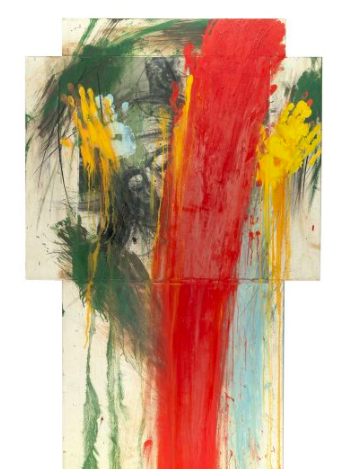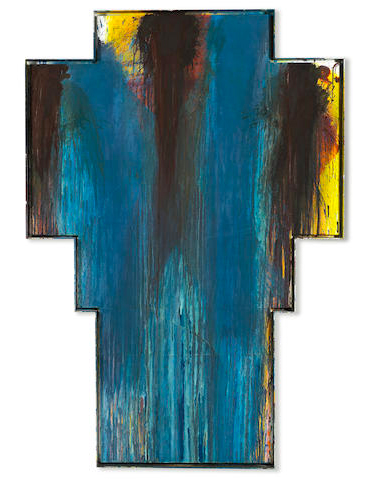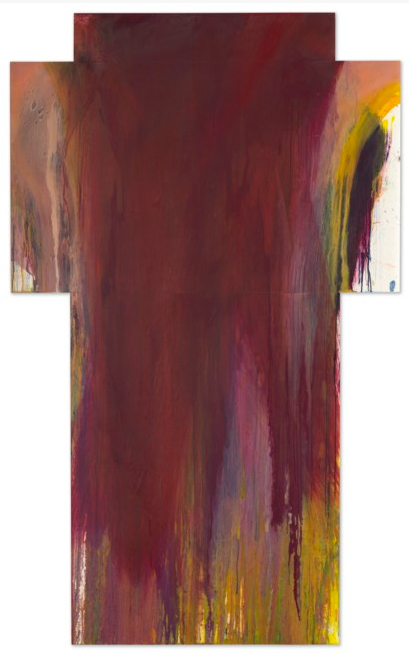April 7: The Cross of Christ
♫ Music:
Day 45 - Friday, April 7
GOOD FRIDAY
Title: THE CROSS OF CHRIST
Scripture: John 19:16-30
So they took Jesus and he went out carrying the cross himself, to a place called Skull Hill (in Hebrew, Golgotha). There they crucified him, and two others, one on either side of him with Jesus in the middle. Pilate had a placard written out and put on the cross, reading, JESUS OF NAZARETH, THE KING OF THE JEWS. This placard was read by many of the Jews because the place where Jesus was crucified was quite near Jerusalem, and it was written in Hebrew as well as in Latin and Greek. So the chief priests said to Pilate, “You should not write ‘The King of the Jews’, but ‘This man said, I am King of the Jews.’”
To which Pilate retorted, “Indeed? What I have written, I have written.”
When the soldiers had crucified Jesus, they divided his clothes between them, taking a quarter-share each. There remained his shirt, which was seamless—woven in one piece from the top to the bottom. So they said to each other, “Don’t let us tear it; let’s draw lots and see who gets it.” This happened to fulfill the scripture which says—‘They divided my garments among them, and for my clothing they cast lots’.
While the soldiers were doing this, Jesus’ mother was standing near the cross with her sister, and with them Mary, the wife of Clopas and Mary of Magdala. Jesus saw his mother and the disciple whom he loved standing by her side, and said to her, “Look, there is your son!” And then he said to the disciple, “And there is your mother!” And from that time the disciple took Mary into his own home.
After this, Jesus realising that everything was now completed said (fulfilling the saying of scripture), “I am thirsty.”
There was a bowl of sour wine standing there. So they soaked a sponge in the wine, put it on a spear, and pushed it up towards his mouth. When Jesus had taken it, he cried, “It is finished!” His head fell forward, and he died.
Poetry & Poet:
“The Twelve”
by Sterling A. Brown
There by some wrinkled stones round a leafless tree
With beards askew, their eyes dull and wild
Twelve ragged men, the council of charity
Wandering the face of the earth a fatherless child,
Kneel, at their infidelity aghast,
For where was it, somewhere in Syria
Or Palestine when the streams went red,
The victor of Rome, his arms outspread,
His eyes cold with his inhuman ecstasy,
Cried the last word, the accursed last
Of the forsaken that seared the western heart
With the fire of the wind, the thick and the fast
Whirl of the damned in the heavenly storm:
Now the wind’s empty and the twelve living dead
Look round them for that promontory Form
Whose mercy flashed from the sheet lightning’s head;
But the twelve lie in the sand by the dry rock
Seeing nothing—the sand, the tree, rocks
Without number—and turn away the face
To the mind’s briefer and more desert place.
THE CROSS OF CHRIST
The earliest surviving examples of visual art are paintings made on cave walls. There, in the perpetual dark, human beings wanted to record their presence, their lives, and to enact rituals, so they invented painting. Creating lasting images with their bare hands must have worked to hold their most sacred meanings, because painting became a permanent feature of human civilization. One common image left by our ancestors, before the time of writing, was a simple handprint. Either in a positive paint-filled impression or in empty silhouette, the handprint served as the most direct representational image that a human being could create, and it served as an indexical mark—in place of a signature. Arnulf Rainer’s crosses, seemingly painted directly with the hand, remind me that human beings continue, even in our post-industrial age, to use an ancient form like painting—and our bare hands—to contend with our most sacred meanings.
Rainer’s crosses evoke altarpieces with their shaped canvases, shallow space, and rich surfaces. Of course, their most remarkable feature is the absence of the figure of Christ. Rather than depicting the human form, the painter evokes his own human presence, contending aggressively with the painting’s surface, asserting his own struggle in relation to the material, and perhaps to the unrelenting meanings of the cross. The painter participates in and enacts the violence of the cross, recording his own wrestling with the sacred image at a particular moment in history. Rainer’s paintings also seem to manifest a desire to touch, to re-aminate a sacred form in the language of contemporary art, to press his own hands against its inescapable meanings.
When our Lord pronounced his work “Finished,” He utterly reversed and confounded what the cross represented. He had “finished” his long, intentional journey of loss and suffering. He gathered to Himself all the hopelessness, helplessness, humiliation, loss, injustice, abuse of power, pain, and death that the cross held, and filled it with new meaning. He had fulfilled all that was written, making possible the reconciliation to Himself of even the most abject spaces of human desperation, degradation, and pain. That day the cross was transformed into the image of our salvation, and of the meaning of human suffering was transformed with it. So, the cross persists, for believers and unbelievers alike, as the central vision with which we all must contend, and to which we must look in order to be saved.
My wife collects crosses. When I travel without her, I often make a point to find one to bring home. I find them everywhere. Perhaps of all the sacred images humans have encountered, this one is still the most difficult to comprehend, the most shocking and comforting all at once. In our home the crosses hang on the wall near our dining room. Most of them fit comfortably in my hand. Each time I look at them, small and lovely as they are. I am challenged again by the reality that there is not a single thing that Christ cannot transform, not a single thing that He will not finish.
Prayer (a declaration):
Jesus, you have made of the Cross
A Tree of Life.
You said that this work Is Finished!
There is nothing in me, or around me,
That lies outside your reconciling work.
Amen.
Jonathan Puls, M.F.A., M.A.
Chair of the Art Department
Associate Professor of Art History and Painting
Biola University
For more information about the artwork, music, and poetry selected for this day, we have provided resources under the “About” tab located next to the “Devotional” tab.
About the Translation of the Bible for the 2023 Lent Project:
J.B. Phillips New Testament Translation of the Bible
J.B. Phillips (1906-1982) was well-known within the Church of England for his commitment to making the message of truth relevant to today's world. Phillips' translation of the New Testament brings home the full force of the original message. The New Testament in Modern English was originally written for the benefit of Phillips' youth group; it was later published more widely in response to popular demand. The language is up-to-date and forceful, involving the reader in the dramatic events and powerful teaching of the New Testament. It brings home the message of Good News as it was first heard two thousand years ago.
https://www.biblegateway.com/
About Artwork #1:
Kreuz (Cross)
Arnulf Rainer
1988–1989
Acrylic over photograph
Mounted in a cross shape on panel
150 x 80 cm
Private Collection
About Artwork #2:
Kreuz (Cross)
Arnulf Rainer
1991–1992
Oil on board
187.3 by 129 cm
Private Collection
About Artwork #3:
Weinkreuz (Wine Cross)
Arnulf Rainer
1991
Oil on cardboard on wood
198.6 x 121 cm
Private Collection
A preeminent master among Austrian painters, Arnulf Rainer is known for his rich and varied exploration of the form of the cross. Crosses and crucifixions are a thread that runs through most of Rainer’s work. He regularly uses other visual material and motifs from Christianity, such as Roman or Byzantine images of Christ or the Madonna. Between 1995 and 1998, he produced a remarkable sequence of overpainted biblical illustrations in which he responded to originals ranging from tenth-century illustrated manuscripts to the art of the nineteenth century. Rainer has created a diverse body of cross-inspired imagery that incorporates different media, including photography, painting, works on paper, and sculpture.
https://artlyst.com/previews/arnulf-rainer-90th-birthday-exhibition-celebrated-albertina-museum/
About the Artist:
Arnulf Rainer (b. 1929) is an Austrian artist known for his use of appropriation of images and his process of layering paint over photographs, transforming existing artworks by layering them with thick, gestural marks. “The principles of my works—are the extinction of expression, permanent covering and contemplative tranquility,” the artist mused. “My ideal is the completely dark picture, full of some overwhelming silence.” The largely self-taught painter is associated with both surrealism and the art informel movements. In 2009, the Arnulf Rainer Museum opened in Frauenbad in Baden, Germany. His works are also included in the collections of the Museum of Modern Art in New York, the Tate Modern Gallery in London, the Ludwig Museum of Contemporary Art in Budapest, and the Los Angeles County Museum of Art, among others. Rainer currently lives and works in Vienna, Austria.
https://www.artnet.com/artists/arnulf-rainer/
https://en.wikipedia.org/wiki/Arnulf_Rainer
https://www.arnulf-rainer-museum.at/en/ausstellungen/archiv/kreuz/
About the Music: “It is Finished” (St. John) from the album Seven Last Words from the Cross
Lyrics:
My eyes were blind with weeping,
For he that consoled me is far from me:
Consider all you people,
Is there any sorrow like my sorrow? 3x
All you who pass along this way take heed
and consider if there is any sorrow like mine.
It is finished
Is there any sorrow like mine
The movement begins with hammer blows which subside and out of which grows quiet choral material which is largely unaccompanied throughout. The three words act as a background for a more prominent text taken from the Good Friday Responsories.
https://www.boosey.com/cr/music/James-MacMillan-Seven-Last-Words-from-the-Cross/6108
About the Composer:
James MacMillan (b. 1959) is a Scottish classical composer and conductor. He studied composition at the University of Edinburgh and at Durham University, where he earned a Ph.D. in 1987. MacMillan's music is infused with the spiritual and the political. His Roman Catholic faith has inspired many of his sacred works, including Magnificat (1999) and several masses. MacMillan has also collaborated with Michael Symmons Roberts, a Catholic poet, and also Rowan Williams, the archbishop of Canterbury. After his formal studies, MacMillan returned to Scotland, composed prolifically, and became associate composer of the Scottish Chamber Orchestra, often working on educational projects. He was composer and conductor of the BBC Philharmonic from 2000 to 2009, after which he took a position as the principal guest conductor with the Netherlands Radio Chamber Philharmonic.
https://www.boosey.com/composer/james+macmillan
About the Performers: London Chamber Orchestra and Chorus
Founded by Anthony Bernard in 1921, the London Chamber Orchestra (LCO) is the UK’s longest standing professional chamber orchestra. Throughout its past one hundred years, the LCO has enjoyed many successes and has become one of the UK’s most compelling and inclusive musical organizations. The LCO is committed to pursuing fresh works and new compositions by regularly commissioning and performing UK premieres by living composers. Previous UK and world premieres include works by Stravinsky, Vaughan Williams, Prokofiev, Hindemith, Poulenc, Sir Peter Maxwell Davies, and James MacMillan.
About the Poetry and Poet:
Sterling A. Brown (1901–1989) was an American professor, folklorist, poet, literary critic, and the first Poet Laureate of the District of Columbia. He chiefly studied Black culture of the Southern United States and was a professor at Howard University for most of his career. In 1923, he earned an M.A.from Harvard University and was employed as a teacher at the Virginia Seminary and College in Lynchburg until 1926. Three years later, Brown began teaching at Howard University and, in 1932, his first poetry collection, Southern Road, was published. He next edited The Negro Caravan, an anthology covering nearly two hundred years of African American poetry. Brown’s poetry was influenced by jazz, the blues, work songs, and spirituals. Like Langston Hughes, Jean Toomer, Countee Cullen, and other Black poets of the period, his writing expresses concerns about race in America. With the arrival of the Great Depression, Brown could not find a publisher for his second book of verse so he turned to writing essays and focused on his career as a teacher at Howard, where he taught until his retirement in 1969. He finally published his second book of poetry, The Last Ride of Wild Bill, and Eleven Narrative Poems in 1975, followed by The Collected Poems of Sterling A. Brown. Brown is known for his frank, unsentimental portraits of Black people and culture, as well as the incorporation of African American folklore and contemporary idiom into his verse.
https://poets.org/poet/sterling-brown
https://en.wikipedia.org/wiki/Sterling_Allen_Brown
About Devotion Author:
Jonathan Puls, M.F.A., M.A.
Chair of the Art Department
Associate Professor of Art History and Painting
Biola University
Jonathan Puls (MFA, MA) is a family man, a painter, and sometimes a writer. He teaches drawing, painting, and art history courses in Biola’s Department of Art and currently serves as its Chair. Jonathan enjoys working with young artists and supporting creative work of all kinds.


